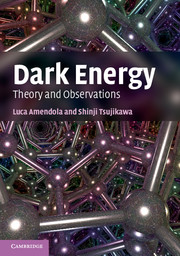Book contents
- Frontmatter
- Contents
- Preface
- List of Frequently used symbols
- 1 Overview
- 2 Expansion history of the Universe
- 3 Correlation function and power spectrum
- 4 Basics of cosmological perturbation theory
- 5 Observational evidence of dark energy
- 6 Cosmological constant
- 7 Dark energy as a modified form of matter I: Quintessence
- 8 Dark energy as a modified form of matter II
- 9 Dark energy as a modification of gravity
- 10 Cosmic acceleration without dark energy
- 11 Dark energy and linear cosmological perturbations
- 12 Non-linear cosmological perturbations
- 13 Statistical methods in cosmology
- 14 Future observational constraints on the nature of dark energy
- 15 Conclusion and outlook
- 16 Answers to the problems
- 17 Mathematical Appendix
- References
- Index
3 - Correlation function and power spectrum
Published online by Cambridge University Press: 05 March 2013
- Frontmatter
- Contents
- Preface
- List of Frequently used symbols
- 1 Overview
- 2 Expansion history of the Universe
- 3 Correlation function and power spectrum
- 4 Basics of cosmological perturbation theory
- 5 Observational evidence of dark energy
- 6 Cosmological constant
- 7 Dark energy as a modified form of matter I: Quintessence
- 8 Dark energy as a modified form of matter II
- 9 Dark energy as a modification of gravity
- 10 Cosmic acceleration without dark energy
- 11 Dark energy and linear cosmological perturbations
- 12 Non-linear cosmological perturbations
- 13 Statistical methods in cosmology
- 14 Future observational constraints on the nature of dark energy
- 15 Conclusion and outlook
- 16 Answers to the problems
- 17 Mathematical Appendix
- References
- Index
Summary
The models of dark energy we will introduce later on are linked to the observations by a precious tool, statistics. Since this world is complicated, we have to average the ups and downs of everyday life to get a sense of the underlying substance. In this chapter we present basic tools of statistics in order to confront dark energy models with observations.
Statistics itself is often divided into descriptive statistics, i.e. how to condense the data in a compact and useful way, and estimation (or inferential, inductive) statistics, i.e. how to derive information on model parameters. We start here with the statistics needed for cosmological perturbation theory, essentially descriptive statistics such as correlation function and power spectrum, and postpone parameter estimation statistics to Chapter 13.
A note on notation is in order here. When there is no real need, we will not use separate notation for an estimator (say, the correlation function) and its expected value. Similarly, when there is no risk of confusion, we will denote vector quantities like position x and wavevector k with unbolded fonts x, k, especially to denote the argument of functions: δ(x) will in general mean the density contrast at a position x. Finally, when an integration, even a multiple one, is extended to the whole space we simply write ∫ d V or ∫ dx. When the domain of integration really matters, then it will be specified.
- Type
- Chapter
- Information
- Dark EnergyTheory and Observations, pp. 27 - 39Publisher: Cambridge University PressPrint publication year: 2010



